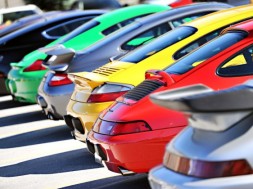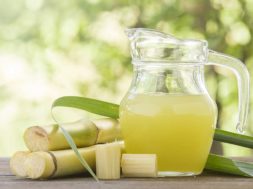“It’s the last thing you do to a car, but it’s the first thing people see.” That’s how Roger Ward puts it. He ought to know. He’s been painting cars for 50 years. Few things can make or break a street rod or custom car like paint. The right paint color and design style will enhance an already cool car, or make an otherwise average one stand out. The wrong one…
Let’s stick to doing it right. The problem is, how do you do it right in a game where there are no rules? When faced with such a question, we did what we always do…ask somebody else–in this case, four of our favorite prominent painter friends: Andre Carey, Zane Cullen, Pete Santini, and Roger Ward. We asked them about current trends and how to pick the best possible paint for a rod or custom.
One point shared by everyone we spoke to was the importance of talking to the painter or designer during the entire process. Although the owner is the client, the painter is the artist and can help the owner determine the paint that will not only look the best on the vehicle, but that will make the owner happy. Andre says he’s had only one customer come in who knew exactly what color he wanted–black. More commonly, customers are daunted by the number of choices from companies like PPG and House of Kolor and appreciate the opinion of a professional.
Personality
Santini tries to figure out who the customer is in order to determine the paint that will suit his wishes. “I’m not going to put airbrushed graphics or lime green flames on a car if the guy’s other car is a Mercedes 500SL.” The car should reflect the owner’s personality as much as his taste, whether it’s sophisticated, conservative, flashy, or otherwise. Zane recommends using an artist or designer who can help a car owner determine whether or not his concepts work in reality and help the painter understand what the owner has in mind.
Theme
The paint is as important to the theme of the car as every other component and should be consistent with the overall theme. Look at the whole car and pick colors that will suit the overall approach. On a ’50s-style rod that would mean colors and styles evocative of that era. If the car is a progressive high-tech ride, maybe you go a little wilder. On a street rod with an elegant interior and more exotic drivetrain, some rich, classy colors might be right.
Function
Finally, painters and owners should consider the car’s intended purpose. If this is a daily driver, skip the $1,000-a-quart pearl paint for the front fenders and stick with simpler paints that can be retouched easily and cheaply–and choose colors that you won’t get tired of looking at every day or that won’t be out of style in two or three years. If the car is meant to be an “in your face” show winner and magazine magnet for only a few years before the next big project, you can be a little bolder and trendier with color and design.
Influences
When picking colors, think beyond what you’ve already seen on other cars, or what you see in paint company palette samples. Pro painters get their influences from all over. Zane studies magazines and drawings for creative ideas. According to Andre, inspiration for colors comes from everything from sunsets to shopping malls. The colors for his Starliner came from one of his dress shirts. Pete Santini also looks to fashion as well as interior design for colors and combinations, and Roger Ward has borrowed from vintage airplane schemes.
Color Combos
Two-tone paint schemes have been growing in popularity, which makes picking the right paint doubly difficult. Traditional combos of neutral and primary colors are always safe, but not always the most interesting. Lately, silvers as well as oranges and coppers have been popular colors in two-tone jobs. Almost all the painters we interviewed identified Troy Trepanier as a master of mixing two disparate colors and making them work. Andre says that one of the tricks when using certain colors that could be overbearing is to use one or the other in moderation. Pete Santini recommends separating two strong colors with a neutral color (such as tan or black) in between, usually a pinstripe. This separates the colors but helps tie them together.
Attention
The purpose of picking the right paint is to draw attention to the car. Roger always encourages his customers to think about unique colors that haven’t been done too many times in order to get some interest. Attention, however, can be a tricky thing. The question is: How much attention you want, and from whom? Bright colors and showy effects like flames and chameleon paint are sure to elicit “oohs” and “aahs” from the general public, but there are many jaded hot rodders who are more discerning. As Roger pointed out, if it’s just attention you want, setting the car on fire will accomplish your goal quickly. A good paint job will call attention to every aspect of the vehicle, instead of overriding them. Your car’s paint is like a woman’s makeup or a man’s suit. It should complement the looks without calling attention to the fact that it’s there.
What’s Hot
We asked the pros what they were seeing and what their customers were looking for that seemed to be the growing trends. Everybody mentioned earth tones-coppers, golds, burnt oranges, browns, cinnamons, and deep reds, as well as shades of green like the colors Chip Foose used on the Grand Master Chevy and Troy Trepanier used on Chicayne. Many of these colors have been around for decades, but, as Zane Cullen noted, modern materials have given them greater depth, gloss, and range. Lighter metallic and pearl colors have taken over as well. Pete Santini sees pewter silver surpassing white in popularity. Flames are continuing to engulf more rods in a wider variety of styles. Everybody acknowledged the big comeback of metalflake. Hot in the ’60s, ‘flake migrated over to the lowrider scene but is quickly making its way back. It’s fun and it’s different. “It’s not like wearing a tuxedo,” Santini said. “It’s like wearing a shiny satin shirt.”
Keep Cool
What’s the secret to making sure the paint you spray today will still look great in 2008? Most painters feel that today’s neutral, classier-looking colors are not likely to go out of style for several years. Roger Ward emphasizes trying to stay ahead of the trends, “getting on the wave early,” as Zane Cullen put it. That involves trusting your instincts. In the end, you’re the expert when it comes to determining your own taste. Don’t worry as much about following a trend as finding a paint color and design style you know you will like for as long as you own your car.
This three-window coupe is…
read full caption
A little color can go a long…
read full caption
Roger Ward says that vintage…
read full caption
Metalflake is coming on strong,…
read full caption
Lettering is making a big…
read full caption
This just-finished ’32 pickup…
read full caption
Bare metal is starting to…
read full caption
Pewter silver, like the paint…
read full caption
The almost three-dimensional…
read full caption
Black primer is literally…
read full caption
Simple rules. Two-stage black…
read full caption
The scallop theme pops up…
read full caption
Easy Free (or Low-$) Paint Tips
*When trying to choose the right color for your ride, narrow the choices down by selecting a particular color “family” first. For example, reds and oranges, or blues and greens, or light metallics, or earthtones.
*Pick a color you can live with for a long time. Paint is expensive. You don’t want to be doing this again in five years.
*A paper match (available for free everywhere) can be used as a makeshift brush to touch up tiny scratches. Remove the match from the book and use the match base (not the sulfur-coated head) as a substitute for a fine paintbrush.
*Pick a color that goes with the style of the car. Don’t paint your Deuce roadster Pepto Pink if you want it to look like it just rolled out of the ’50s.
*Ask for second opinions on color combos from friends or spouses who have good taste. Don’t ask for advice from your buddy who wears plaid pants and white patent-leather shoes.
*Don’t ask too many people, though. Outside opinions are valuable, but too much input can lead to confusion, bland committee decisions, or a tasteless mish-mash of disparate elements.
*Have an artist help you by drawing or designing various paint colors and schemes, using either pens and paint or computer-illustration software.
*Be wary of trendy colors that are hot at the moment. Remember all that aqua and pink from 10-15 years ago? It looks dated today.
*Provide contrast, whether it’s chrome or contrasting-color wheels, grille, etc. Too much of one color can be just that–too much. Most big-name builders are putting side trim and other limited brightwork on cars again.
*Don’t paint yourself into a corner. There’s nothing wrong with picking a color early, just be open to advice as the build process continues.
*Enamel and urethane can be sprayed over other paint, including lacquer, that has cured. Lacquer, on the other hand, adheres by etching into the surface and cannot be applied over enamel or urethane paint. Keep in mind that lacquer is illegal to use in many places, including California.
*Painting from a rattlecan can be tough in cold weather (meaning temps below 70 degrees F). Try warming up the spray can by running it under warm (not hot) water for a few seconds then shaking the can to distribute the warm paint. Never run pressurized aerosol cans under hot water.
*Touch up hard-to-reach areas or tiny paint chips too small for a sandpiper with a sanding pen, such as the Spot Sanding Pen from 3M or the PrepPen from Pro Motorcar Products. They resemble ink markers and have a pointy tip containing thousands of glass fibers that reach where sandpaper can’t. You can find them all over the Internet.
*Black, red, yellow, orange-these have always been the most prevalent colors on hot rods and customs. Why not white? Benefits of this non-color are that it’s cooler (temperature-wise anyway) than dark colors, doesn’t show dirt or flaws as easily, goes with any other color, and makes a great base for flames or other graphics.
*Testing colors on lightbulbs is an old trick from the ’50s (Larry Watson used it), still used today. Spherical objects work better than flat surfaces because they allow you to see how the paint will look on curves and in a variety of light and shade situations.
*When painting, keep color off the rubber and rims by using wheel and tire covers–a far easier alternative to masking tires and wheels. The store that sold you the paint probably carries these. Or mount an old set of wheel and tires while painting the car. You’ll still have to mask off the wheelwells but not the rolling stock.
*Ensure a tabletop-smooth finish by spraying a light coat of black paint over the primered sheetmetal. After sanding the panel smooth with 320-grit sandpaper, you’ll notice all the slight depressions indicated by the black paint. Reprimer and repeat until you’ve got a smooth surface.
* Here’s how to remove outline masking tape without goofing up the graphics: Use a slow, steady motion and always pull the tape straight back. Pulling into or away from the fresh paint can create a tear or otherwise blemish the finish.
*Read lots of car magazines. Go to lots of car shows. Look at what the pros have done for ideas you can adapt to your own vision.
*Be careful with gimmicks, such as chameleon paint, metalflake, unusual graphics, and other styles that may be a passing fad.
*When selecting colors, don’t limit yourself to color chips in books. Look for colors on new car lots and late-model cars on the street. Pay attention to how the color changes in different lights and angles, and try to image how it would work on your car.
* Building a driver? Talk to your painter or paint rep about paints and colors that are easy to touch up. If you’re using a custom-blended hue, be sure to mix up a little extra for touch-ups.
*The Paint Pen from Eastwood Company is another pen-like product that is very useful. Each disposable pen holds 1/3 ounce of paint and is intended for touching up nicks and chips, or for small-detail work. Eastwood also has Touch-Up pens pre-loaded with fast-drying enamel paint in popular colors, plus “Aluma Blast” and “Almost Chrome.”
*Be honest with yourself. A wild paint job may look cool on somebody else’s car, but don’t go too crazy with your own paint scheme if your own taste is more conservative. After the initial rush wears off, you may wonder what the heck you were thinking.





